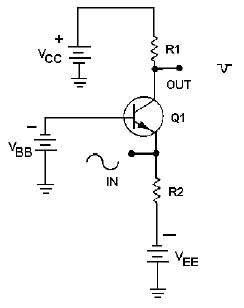1-9
Figure 1-7.—A simple class C transistor amplifier.
Class C amplifiers are used where the output signal need only be present during part of one-half of
the input signal. Any amplifier that operates on less than 50% of the input signal is operated class C.
Q-7. What determines the class of operation of an amplifier?
Q-8. What are the four classes of operation of a transistor amplifier?
Q-9. If the output of a circuit needs to be a complete representation of one-half of the input signal,
what class of operation is indicated?
Q-10. Why is class C operation more efficient than class A operation?
Q-11. What class of operation has the highest fidelity?
AMPLIFIER COUPLING
Earlier in this module it was stated that almost every electronic device contains at least one stage of
amplification. Many devices contain several stages of amplification and therefore several amplifiers.
Stages of amplification are added when a single stage will not provide the required amount of
amplification. For example, if a single stage of amplification will provide a maximum gain of 100 and the
desired gain from the device is 1000, two stages of amplification will be required. The two stages might
have gains of 10 and 100, 20 and 50, or 25 and 40. (The overall gain is the product of the individual
stages-10
100 = 20
50 = 25
40 = 1000.)
Figure 1-8 shows the effect of adding stages of amplification. As stages of amplification are added,
the signal increases and the final output (from the speaker) is increased.


